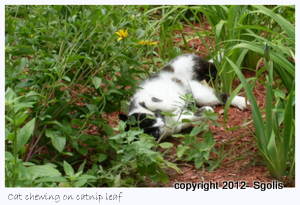Many
feral, neighborhood and stray cats are attracted to my yard due to the catnip
garden. We encourage the cats to come to
our yard for safety and for shelter. The cats will spend the entire day in the garden and this is an effective way to keep them off the neighborhood streets.
Catnip
(Nepeta cataria) is a plant that cats are attracted to. When the cat rubs on the plant it will emit a
fragrance. This fragrance will trigger
specific cat behaviors; rolling, pawing, licking chewing on the plant, they may
also rub the side of their head or their chin on the plant.
Cats that do not get along will become friendly with other cats provided they are able to pleasure themselves with catnip.
Cats that do not get along will become friendly with other cats provided they are able to pleasure themselves with catnip.
Here are a few photos of Tuxedo cat and catnip.
The catnip
in this particular garden is grown with Black-eyed Susan flowers:
The catnip
that grows in my yard was planted from seed.
You do not need special soil as it is not fussy except that the soil
should be well drained. Many people
report that the catnip reseeds itself and that it can take over the
garden. I don’t have this problem due to
the cats that frequent my yard. I plant catnip every year.
In late
winter I will start seed by growing it indoors six to eight weeks before the
last spring frost. I will grow indoors next to a sunny window and will
transplant outdoors after the threat of frost has past in spring. I find that plants with several leaves do better
when they are transplanted on a warm day.
You can
also sow the seed into a prepared garden.
Choose a garden area that has full sun.
Cover the seeds with 1/8 inch of soil and water. Keep the soil evenly moist but not wet. Mature plants do not require as much
water. I water the plants an inch of
water per week. A deep watering will
hydrate the roots and is better than watering catnip a little each day.
Since cats
are in my yard I must protect the seeds and the transplants. In the spring I will keep the cats away from
the catnip garden with chicken wire fencing.
The fence does not come down until the plants are mature. Mature plants will grow up to three feet tall
so choose a catnip garden site that provides the plants with ample room to
grow.
For indoor
cats you would harvest catnip before the plant flowers bloom. Remove the leaves from the stem then air dry
the leaves. When the leaves are completely dried you would crumble them and
then you can store the catnip in an air tight jar. Fill your cats cloth toys
with the catnip and you will provide kitty with hours of fun.
You can grow
catnip in a container for your indoor cats.




